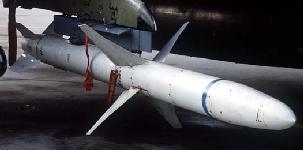
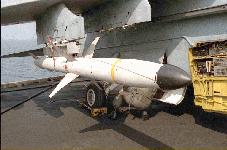
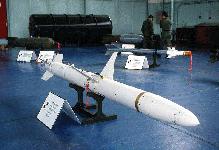
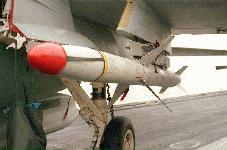
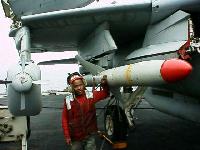

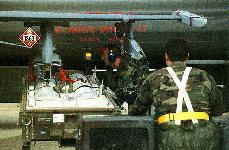
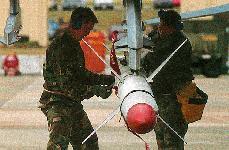
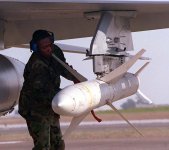




The AGM-88 HARM (high-speed antiradiation missile) is a supersonic air-to-surface tactical missile designed to seek and destroy enemy radar-equipped air defense systems. The AGM-88 can detect, attack and destroy a target with minimum aircrew input. Guidance is provided through reception of signals emitted from a ground-based threat radar. It has the capability of discriminating a single target from a number of emitters in the environment. The proportional guidance system that homes in on enemy radar emissions has a fixed antenna and seeker head in the missile nose. A smokeless, solid-propellant, dual-thrust rocket motor propels the missile. The Navy and Marine Corps F/A-18 and EA-6B have the capability to employ the AGM-88. With the retirement of the F-4, the F-16C is the only aircraft in the current Air Force inventory to use the AGM-88. The B version has an improved guidance section which incorporates an improved tactical software and electronically reprogrammable memory.
The AGM-88 missile was approved for full production by the Defense Systems Acquisition Review Council in March 1983. The Air Force equipped the F-4G Wild Weasel with the AGM-88 to increase the F-4G's lethality in electronic combat. The missile worked with the APR-47 radar attack and warning system on the aircraft. The missile is operationally deployed throughout the Air Force and in full production as a joint US Air Force-US Navy project. HARM continues to prove its value against continuously emitting threat radar. Over 80 missiles were fired from USN/USMC aircraft both during and post Desert Fox.
The AGM-88A/B HARM is an evolution of anti-radiation missile weapon systems, SHRIKE and STANDARD ARM. HARM incorporates the more desirable features of each while providing additional capabilities that enhance operational effectiveness. Although generally similar in appearance and mission to the AGM-45 Shrike, produced more than 25 years prior to the AGM-88, the AGM-88 HARM is several feet longer than an AGM-45, has a slightly-enlarged diameter a foot back from the nose, and has a slightly greater diameter overall. The AGM-45 also has an RF window/slot on the side, not present on the AGM-88.
The system consists of the guided missile, LAU-118(V)1/A launcher, launch aircraft, and HARM peculiar avionics. The weapon system has the capability of detecting, acquiring, displaying, and selecting a radiating threat and launching a missile or missiles. The HARM Missile receives target parameters from the launch aircraft prior to launch. The HARM Missile uses these parameters and relevant attitude data to process incoming RF energy to acquire and guide the HARM Missile to the desired target. The HARM missile has a terminal homing capability that provides a launch and leave capability for the launch aircraft. Additional unique features include the high speed, low smoke, rocket motor and seeker sensitivity that enable the missile to easily attack sidelobes and backlobes of an emitter.
The following provides functional descriptions for each section of the HARM Missile and significant enhancements.
Guidance Section. Several modifications have been made to the HARM Guidance section through hardware modifications and software upgrades.
Hardware Configurations. The AGM-88A was the first version of the missile to be produced. It incorporated a fuzable-link memory that required the guidance section to be returned to the manufacturer to change the Tactical software. The AGM-88B missile was developed in the mid 1980s and incorporated an electronically reprogrammable memory that allowed changing the missile software in the field. The AGM-88C missile is the latest version and incorporates several new design features and is also reprogrammable in the field.
Software Versions. Block I software was the original Tactical software used with the AGM-88A missile. Block II software provided guidance and fuzing improvements and was used in both AGM-88A missiles and AGM-88B missiles. In 1990 Block III software was installed in AGM-88B missiles to counter the capabilities of the advanced threats. All AGM-88C missiles contained Block IV software which is currently the latest version.
Warhead Section. The warhead section is designed to inflict sufficient damage on the target antenna and waveguide system to force an inoperative condition. It also ensures complete destruction of the HARM Missile guidance section.. The AGM-88A, and AGM-88B warhead section contains 25,000 pre-formed steel fragments, an explosive charge, a fuze, and a fuze booster. The AGM-88C utilizes an improved warhead section containing 12,845 tungsten fragments and an improved explosive charge which provides greater overall lethality.
Control Section. The control section of the HARM Missile is located aft of the warhead section. The control section contains wing actuators to steer the missile on a desired trajectory, missile captive and free flight electrical power supply equipment, attitude reference equipment, and the missile target detection device. An umbilical connector mounted on top of the control section provides electrical interface between the launch aircraft and the missile.
Rocket Motor Section. Thrust for the HARM Missile is developed by a dual thrust rocket motor utilizing a low smoke propellant. The section contains a manually operated safety-arming device, igniter, propellant grain, and a fixed nozzle. External components on the rocket motor section consist of fittings for the fins, launch lugs, and a detent rib.
Wings. The wings direct the course of the HARM Missile in flight by internally controlled actuators within the control section. Four wings are required per missile.
Fins. The BSU-60/B and BSU-60A/B fins are identical type fins except for a redesigned locking mechanism. They are interchangeable as sets. The fins provide aerodynamic stability of the HARM Missile during flight.
Antiradiation missiles have an unparalleled ability to home in on enemy emitters and disrupt or destroy the elements of an integrated air defense system (IADS). However, they are not classic precision-guided weapons, such as laser-guided munitions. On the contrary, ARMs cannot be steered and under certain conditions may not guide on the target that they were originally fired. Also, they do not have the ability to discern friend from foe. Therefore, the precision detection capability of the launching platform and its human operator in the loop are key elements ensuring weapon effectiveness and the prevention of fratricide. The translation of what the launching aircraft sees to what the ARM sees is paramount.
Several unique factors effect ARM employment. Most significant are the ambiguities in the radar frequency spectrum which cause friendly, enemy, and neutral radar emissions to appear similar. Ambiguities make accurate platform targeting and missile guidance difficult. These ambiguities will continue to worsen as the frequency spectrum becomes more dense and overcrowded. A limited amount of frequencies is suitable for radar operations, and as newer systems evolve, more emitters will overlap. In some instances, high target area activity in a dense emitter environment may cause cockpit task saturation and decrease targeting efficiency. Now previously defined enemy emitters from the Soviet era cannot be exclusively classified as such. Potential partners in multinational combined operations may employ such systems, causing use of the same weapon system on both sides of a conflict. For example, in Desert Storm, coalition forces and Iraq both used the SA-6 and Hawk weapon systems. As systems intermingle during changing world political conditions, it will become increasingly difficult to detect friendly, enemy, and neutral radar emitters.
Rules of engagement (ROE) compensate for some of the above problems. Restricting weapons firing until specific conditions are met reduces potential fratricide as well as avoids inefficient weapons employment. However, ROE must be optimized for all platforms in theater and take into account each system's capabilities and limitations. Each service employs ARMs with different objectives and philosophies. Individual service platforms can employ ARMs with varying degrees of accuracy. To improve integration during a joint campaign, each service must understand how the other executes ARM employment. Likewise, inaccurate targeting and fratricide is prevented by knowing how friendly ground and naval emitters operate. Joint planners must extensively coordinate all aspects of ARM employment during a SEAD campaign. Critical to planning is the transmission of friendly emitter order of battle information to the aircrews. Timely, accurate data, combined with appropriate ROE and knowledge of ambiguous theater systems, will overcome the obstacles presented by a dense frequency spectrum.
The CP-1001B/C HARM Command Launch Computer (CLC) is an electronics subsystem installed on the airframe to interface with the AGM-88 A/B/C HARM Missile. The CLC and associated software package are compatible with all AGM-88 A/B/C missiles. The CLC receives target data from the missile and onboard avionics, processes the data for display to the aircrew to the appropriate display, determines target priority, and collects aircraft data for pre-launch hand-off to the AGM-88 HARM missile. The CLC determines time coincidence between the AGM-88 HARM missile and the RWR directional data and pulse repetition intervals and formats. The identification data is processed by the CLC to perform target identification, prioritization, and display information. The CLC generates targeting commands to the AGM-88 HARM missile for appropriate target and provides Targeting and guidance information for the AGM-88 to Target Of Interest (TOI) on offensive attack missions.The primary lethal Supression of Enemy Air Defense [SEAD] platform, the F-16 employing AGM-88 High Speed Anti-radiation Missiles (HARM) has several shortfalls. It is becoming increasingly difficult to logistically support the F-16 and the HARM. SEAD forces have limited automated mission planning capability. It is very difficult to stimulate, decoy, and saturate enemy threat radars without putting friendly forces in harm's way, and the ability to reactively target surface-to-air threats is limited. The ability to employ off-board targeting sources is limited in the timeliness and accuracy required for the preemptive destruction mission. Though offboard sources may find mobile targets, there is a limited capability to pass required information in real time so fighters can reactively or preemptively target mobile surface-to-air threats. There is no on-board capability to preemptively target mobile surface-to-air threat systems. Current SEAD weapons all depend on RF homing for guidance and are vulnerable to emission control (EMCON) countertactics. There is also limited capability to perform real-time battle damage assessment (BDA). On the non-lethal side, there is limited capability to suppress RF threats and C2 systems.
For the future, CINCS are demanding reliable, one-shot hard kills against threat radar, even if the radar shuts down prior to missile impact. The Navy has a three-step program to develop this capability for HARM.
Specifications | |
| Primary Function: | Air-to-surface anti-radiation missile |
| Mission | Defense suppression |
| Targets | Fixed soft |
| Service | Navy and Air Force |
| Contractor: | Raytheon [Texas Instruments] |
| Program status | Operational |
| Date Deployed: | 1984 |
| Power Plant: | Thiokol dual-thrust rocket motor |
| Thrust: | Dual thrust |
| Length: | 13 feet, 8 inches (4.14 meters) |
| Launch Weight: | 800 pounds (360 kilograms) |
| Diameter: | 10 inches (25.40 centimeters) |
| Wingspan: | 3 feet, 8 inches (101.60 centimeters) |
| Range: | 30 plus miles (48 plus kilometers) |
| Speed: | Max. speed: 2280 km/h |
| Guidance System: | Proportional |
| Guidance method | Homes on electronic emissions |
| Warhead | WAU-7/B, 143.51bs. Direct Fragmentation |
| Explosive (NEW) | PBXC-116 (45.2 lbs.) |
| Fuze | Pulsed Laser Proximity/Contact |
| Propulsion | Boost Sustain 64,000 lbs./sec. Low Smoke |
| Development cost | $644.5 million |
| Production cost | $5,568.1 million |
| Total acquisition cost | $6,212.6 million |
| Acquisition unit cost | $316,856 |
| Production unit cost | $283,985 |
| Quantity | 19,607 (Navy and Air Force) |
| Platforms | F/A-18, F-4G, F-16 |









